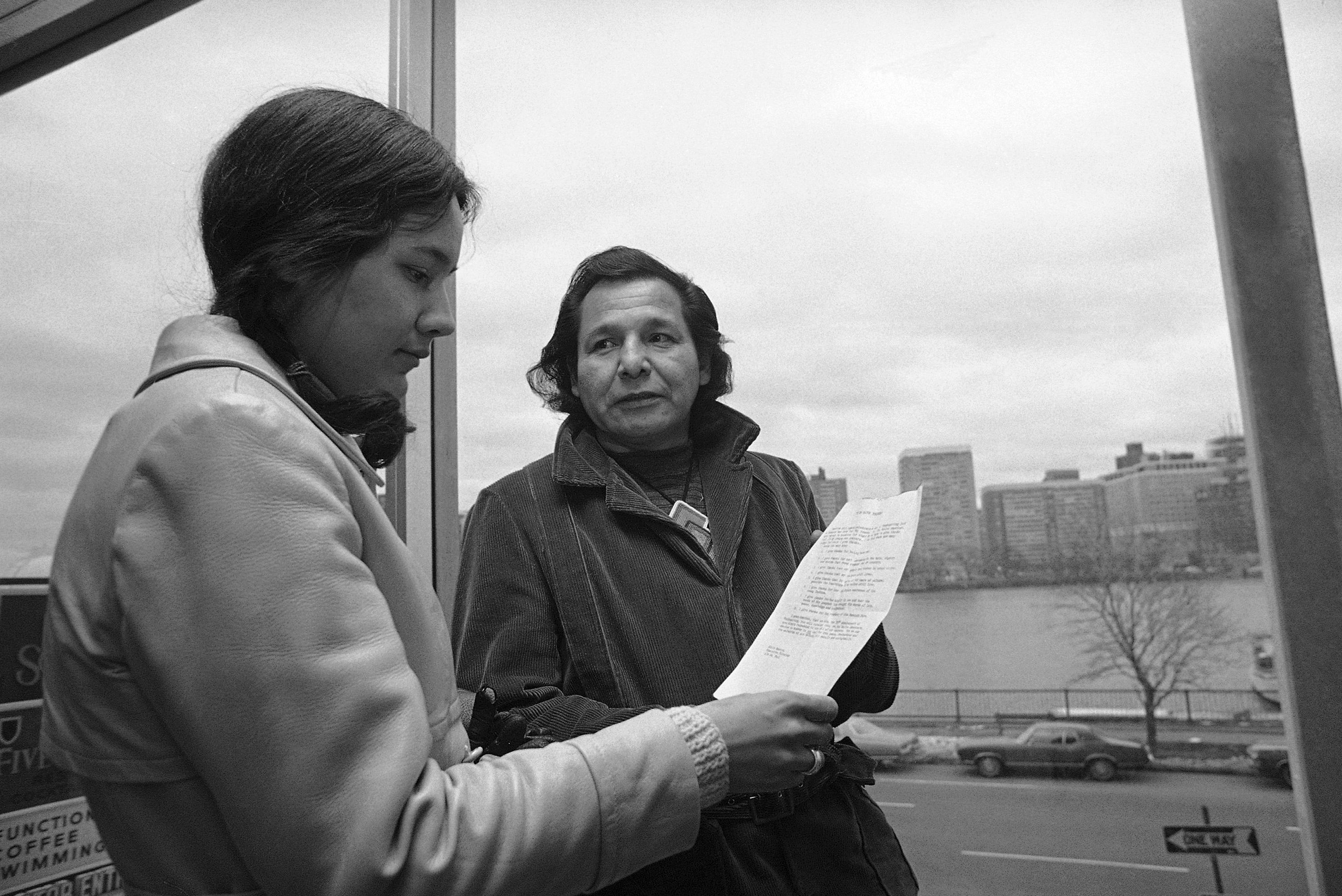Benton-Banai, co-founder of American Indian Movement, dies
Eddie Benton-Banai, one of the founders of the American Indian Movement that was formed partly in response to alleged police brutality against Indigenous people, has died

Your support helps us to tell the story
From reproductive rights to climate change to Big Tech, The Independent is on the ground when the story is developing. Whether it's investigating the financials of Elon Musk's pro-Trump PAC or producing our latest documentary, 'The A Word', which shines a light on the American women fighting for reproductive rights, we know how important it is to parse out the facts from the messaging.
At such a critical moment in US history, we need reporters on the ground. Your donation allows us to keep sending journalists to speak to both sides of the story.
The Independent is trusted by Americans across the entire political spectrum. And unlike many other quality news outlets, we choose not to lock Americans out of our reporting and analysis with paywalls. We believe quality journalism should be available to everyone, paid for by those who can afford it.
Your support makes all the difference.Eddie Benton-Banai, who helped found the American Indian Movement partly in response to alleged police brutality against Indigenous people, has died. He was 89.
Benton-Banai died Monday at a care center in Hayward Wisconsin, where he had been staying for months, according to family friend Dorene Day. Day said Benton-Banai had several health issues and had been hospitalized multiple times in recent years.
Benton-Banai, who is Anishinaabe Ojibwe, was born and raised on the Lac Courte Oreilles reservation in northern Wisconsin. He made a life of connecting American Indians with their spirituality and promoting sovereignty, and was the grand chief, or spiritual leader, of the Three Fires Midewiwin Lodge. Day said he was someone people looked to for guidance in the religious practice of the Anishinaabe Ojibwe people — and he gave countless babies their traditional names.
Benton-Banai’s place in the American Indian Movement, a grassroots group formed in 1968, can be traced to his launch of a cultural program in a Minnesota prison, said co-founder Clyde Bellecourt.
Bellecourt was in solitary confinement when he heard someone whistling “You are My Sunshine," and he looked through a tiny hole in his cell and saw Benton-Banai, a fellow inmate, recognizing him as an Indigenous man.
Bellecourt said Benton-Banai approached him about helping incarcerated Indigenous people, and they started the prison's cultural program to teach American Indians about their history and encourage them to learn a trade or seek higher education. Bellecourt said that Benton-Banai thought they could do the same work in the streets, and the program morphed into the American Indian Movement, an organization that persists today with various chapters.
“It started because I met Eddie in jail,” Bellecourt said. “Our whole Indian way of life came back because of him. … My whole life just changed. I started reading books about history of the Ojibwe nation… dreaming about how beautiful it must have been at one time in our history.”
One of the group's first acts was to organize a patrol to monitor allegations of police harassment and brutality against Native Americans in Minneapolis where it's based. Its work included job training, efforts to seek better housing and education for Indigenous people, provide legal assistance and question government policies.
At times, the American Indian Movement's tactics were militant. In one of its most well-known actions, the group took over Wounded Knee on the Pine Ridge Reservation in South Dakota to protest U.S. and tribal governments. The 71-day occupation turned violent, and two people died in a shootout.
Akim Reinhardt, a history professor at Towson University in Maryland, said Benton-Banai's roots in the group often got overshadowed by more powerful personalities in the movement including Russell Means, Dennis Banks and John Trudell.
“It's a shame, because clearly when we listen to the people who were there, they all mention him," said Reinhardt, who has written broadly about the movement.
Lisa Bellanger, executive director of the National American Indian Movement and Benton-Banai's former assistant, said he was instrumental in the group's work using treaties to protect the rights of Indigenous people. He was also part of a team that pushed for the American Indian Religious Freedom Act of 1978, she said, as government policies stifled or outlawed religious practices. The law safeguarded the rights of American Indians to practice their religion and access sacred sites.
Bellanger said Benton-Banai also helped launch the International Indian Treaty Council, which advocates for the rights of Indigenous nations to govern themselves, and for the protection of tradition, culture and sacred land.
But in addition to his activism work, Benton-Banai was also a father figure.
“We could always go to him with questions," Bellanger said. “We could run crying to him if we needed to. We had that personal faith and trust and love in him, at a time that was crucial for young girls.”
Day said Benton-Banai was raised by his grandparents and grew up speaking Ojibwe.
“He had a very solid spiritual foundation to his traditional and Indigenous learning, and that’s what made him, I believe, who he was,” she said.
His book, “The Mishomis Book” is touted as the first of its kind to offer Anishinaabe families an understanding of spiritual teachings.
Benton-Banai also founded a school in St. Paul in 1972, called the Red School House, which — along with its sister school in MInneapolis — fueled a broader movement to provide alternative education for Indigenous children so they could learn while maintaining their spiritual and cultural practices, Day said.
Bellecourt said American Indian Movement's philosophy of using the sovereignty and spirituality of Indigenous people as a strength can be attributed to Benton-Banai's leadership.
“I considered him our holy man," he said.
___
Associated Press writer Felicia Fonseca in Flagstaff, Arizona, contributed to this report.